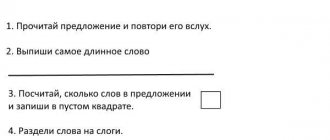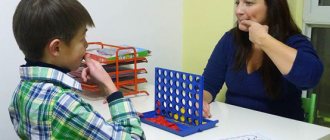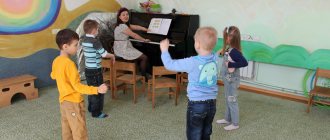There are different opinions about a child with mental retardation in kindergarten. For parents, the question arises whether to send him to a correctional or regular children's educational institution. It is believed that mental retardation is a mild deviation, since the symptoms for many are quite mild if it is not accompanied by secondary diagnoses. The greatest difficulty for such children is only social adaptation in a team with other children. As a rule, their mental development is within normal limits, and the curriculum is more or less assimilated. They may have problems with self-care and neatness skills, but they gradually learn them by watching others. My opinion is that it is better to send children with minor mental retardation to a regular kindergarten, where there is an example of normative behavior.
When it comes to a child with mental retardation with additional diagnoses (ADHD, speech pathologies, cerebral palsy and other motor disorders, secondary decline in intelligence, etc.), I advise you to think about a correctional kindergarten. There are many reasons for this: firstly, the accompanying deviations greatly leave an imprint on different areas of the child’s development, and not just at the time of adaptation and integration into the team; secondly, such institutions employ specialists, create a favorable learning and development environment, and create individual educational routes for each student. In fact, it is easier for a complex child with mental retardation to adapt and at least partially overcome his illnesses before school in a simplified environment where he will not feel like a “black sheep.”
My daughter Anya is a child with mental retardation and related diagnoses, i.e. our version is just less favorable according to forecasts. She has been officially diagnosed with ADHD, ODD (now already grade 3), motor impairments, which are expressed in underdevelopment of fine motor skills, poor coordination, ataxia (at the moment already in a residual form), and peculiarities of the emotional-volitional sphere. Simply put, it will not cope with an ordinary kindergarten, where another 25-30 children with normal development run around, and the teachers do not have experience working with individuals. I chose a correctional kindergarten. We ended up in a group for children with disabilities (disabilities), where there are children with mental disorders, speech disorders, hyperactivity and attention deficit, cerebral palsy, mental retardation, etc. Why was I not afraid of such a “company” and chose a kindergarten for children with mental retardation, and not a regular or logo group?
A child with mental retardation in kindergarten in a regular group
Initially, we were given a place in an ordinary garden right in the yard, near our house. I was happy and consoled myself with the thought that Anya would definitely get used to the group and would soon catch up with the ordinary kids in speech, behavior, and even in her self-care skills. How disappointed I was when I came to the manager and visited the group to which we received a ticket...
There are 35 children on the list; 20-22 children regularly attend preschool educational institutions. Considering that Anya has ADHD and it is difficult to capture her attention even with individual interaction, I immediately realized that in these conditions she would “stick” to her own little world somewhere in the corner or, on the contrary, she would start jumping around without stopping amid the general noise , without delving into the essence of what is happening. What child will come home in the evening?
The manager honestly said that the staff does not know how to work with such children. They cannot create an individual program for her, and, alas, she is not yet suitable for a general program for her age category. Such a break with other children will negatively affect her mental state. In addition, children will quickly understand her otherness and may offend her. She does not know how to stand up for herself, because although aggression is characteristic of her, she directs it into space or at herself, and not at a living person. Most likely, Anya would have become an outcast, whose ineptitude everyone made fun of every day.
Regarding the training program, there are also nuances here. Previously, a child with developmental delays could be placed in a younger age group. Now this is prohibited, and from time to time commissions from the Education Committee carry out inspections. This option was immediately ruled out. At the time of admission to the kindergarten, Anya was 5 years old. The program for her peers assumed a completely different level of development and pace of activity in the classroom. She would not have been able to withstand such a rhythm, although she already knew how to read and count. But at that time, completely undeveloped fine motor skills would not have allowed her to take many lessons in modeling, drawing, origami, etc. And attention, which is defective in all respects, would knock her out of the general regime. Let’s not forget that ZPRok’s behavior is infantile, and the perception of the surrounding reality is too one-sided and flat. She would simply get lost.
Speech problems also left their mark. At 5, children speak with all their might in complex sentences, but Anya had difficulty forming a simple statement, since OSD is a multifaceted disorder of speech development. An ordinary speech therapist in an ordinary kindergarten does not know how to work with complex pathologies. She needed a speech pathologist-defectologist who corrects the phonetic, phonemic, lexical and grammatical aspects of speech as a whole. I think I was not mistaken in assuming that Anya would only be nervous, aggressive and withdrawn into her own emotions if she found herself in such conditions for the whole day.
I know stories where children came to a regular kindergarten, and a few months later there was a nervous breakdown due to the impossibility of full inclusion in the children's society. When moving to a correctional kindergarten, the child’s condition improved.
There is another significant disadvantage for a child with mental retardation in a regular kindergarten - the attitude of other parents. If your baby is very different from the norm, shows negative aspects of behavior, often fights, sets a bad example, parents will show dissatisfaction with you, write complaints to the head and even demand that you be transferred to another kindergarten. I think neither you nor the child need such hassle. Moral pressure from the majority still undermines your confidence, regardless of the fact that today the program of any preschool educational institution is aimed at tolerant and currently popular inclusion.
Keep in mind that many educators will not even be able to feed a special child normally if he has not yet developed self-care skills and does not speak. They are afraid of such children, their reactions, needs, because they are not trained to communicate with them. One of your children will distract her from a crowd of 20-30 people, respectively, except for internal irritation, your baby will not receive anything, at least this is the relationship of 80-90% of ordinary educators and nannies. We can demand, swear, prove, but the fact remains a fact - the child is uncomfortable where he is not understood and shunned, or, even worse, humiliated and ignored.
Recommendations for the admission of children with mental retardation to preschool educationconsultation
Recommendations for the admission of children with mental retardation to preschool institutions and special purpose groups
Children with mental retardation have potentially intact intellectual development capabilities, but they are characterized by impaired cognitive activity due to the immaturity of the emotional-volitional sphere, decreased performance, and insufficiency of a number of higher mental functions. Violations of the emotional-volitional sphere and behavior are manifested in weakness of volitional attitudes, emotional instability, impulsivity, affective excitability, motor disinhibition or, conversely, lethargy and apathy.
Insufficient expression of cognitive interests is combined with immaturity of higher mental functions, disturbances of attention, memory, functional insufficiency of visual and auditory perception, and poor coordination of movements. Underdevelopment of speech can manifest itself in violations of sound pronunciation, poverty and insufficient differentiation of the dictionary, and difficulties in mastering lexical and grammatical structures.
A significant proportion have insufficient phonetic-phonemic perception and a decrease in auditory-verbal memory. Even with the external well-being of oral speech, verbosity or, conversely, insufficient development of the statement is often noted.
A decrease in cognitive activity is manifested in limited knowledge about the world around us and practical skills appropriate to age and necessary for starting school. Low differentiation of hand movements, difficulties in forming complex serial movements and actions negatively affect productive activities (modelling, drawing, designing).
Insufficient readiness for school is manifested in the delayed formation of age-appropriate elements of educational activity.
The child accepts and understands the task, but needs timely help from an adult to master the method of action and transfer what has been learned to other objects and actions when performing subsequent tasks. The ability to accept help, assimilate the principle of action and transfer it to similar tasks significantly distinguishes children with mental retardation from mental retardation and reveals higher potential for their mental development.
Children of the 7th year of life with mental retardation have some mathematical concepts and skills: they correctly indicate a larger or smaller group of objects, reproduce a number series within five (then they often make mistakes); When counting backwards, they have difficulty counting a small number of objects (within five), but find it difficult to name the final result. In general, solving age-appropriate mental problems at a visual and practical level is accessible to children, but they sometimes find it difficult to explain cause-and-effect relationships.
They listen to simple short stories and fairy tales with attention, retell them with the help of questions, but soon forget them; they understand the general meaning of what they read.
Children's play activities are characterized by their inability to develop a joint game without the help of an adult in accordance with a common plan, while they do not take into account common interests, and there is no control over their own behavior. They usually prefer active play without rules.
With significant heterogeneity in the clinical and psychological structure of children with mental retardation in preschool age, along with immature mental functions, there are intact ones that can be relied upon when planning corrective measures.
Children with mental retardation are referred by specialists from medical and treatment-and-prophylactic institutions to a medical-psychological-pedagogical commission (PMMC) to resolve the issue of placing them in the appropriate children's institution, where therapeutic and corrective measures are carried out.
The decision to send or refuse to send a child to a preschool institution or special group is made by the PMPK based on the submitted documents, conversations with parents and examination of the child.
The main medical indicators for admission to preschool institutions and groups for children with mental retardation are:
- ZPR of cerebral-organic origin;
- ZPR according to the type of constitutional (harmonious) mental and psychophysical infantilism;
- ZPR of somatogenic origin with symptoms of persistent somatic asthenia and somatogenic infantilization;
- mental retardation of psychogenic origin (pathological personality development of a neurotic type), psychogenic infantilization,
- ZPR due to other reasons.
Another indication for admission to preschool institutions is pedagogical neglect due to unfavorable microsocial conditions of upbringing.
Under equal conditions, children with more severe forms of mental retardation - cerebral-organic origin and other clinical forms complicated by encephalopathic symptoms - should be sent first to institutions of this type.
In cases where the final diagnosis of a child can only be established during long-term observation of him, the child is admitted to a preschool institution conditionally for 6-9 months. If necessary, this period may be extended.
Children who have the following clinical forms and conditions are not eligible for admission to preschool institutions or groups of this type:
- mental retardation, organic, epileptic, schizophrenic dementia;
- severe hearing, vision, and musculoskeletal disorders;
- severe speech disorders (alalia, aphasia, rhinolalia, dysarthria, stuttering);
- schizophrenia with a pronounced disorder of the emotional-volitional sphere;
- pronounced forms of psychopathy and psychopath-like states of various natures;
- frequent convulsive paroxysms requiring systematic observation and treatment by a neuropsychiatrist;
- persistent enuresis, encopresis;
- chronic diseases of the cardiovascular system, digestive organs in the acute stage and decompensation.
Note. Children who are not subject to education in preschool institutions of this type are sent to the appropriate institutions of the educational system or to institutions of the health care or social security system.
If during the child’s stay in a preschool institution or group for children with mental retardation, the above violations are revealed, the child is subject to expulsion or transfer to an institution of the appropriate profile. The issue of expulsion or transfer of a child is decided by the PMPC.
After a child’s stay in a preschool institution or a group for children with mental retardation, taking into account the updated diagnosis and based on the decision of the pedagogical council of the preschool institution, documents are drawn up to transfer him to a school (class) for children with mental retardation or to a general education school (in some cases - about referral to a special school of the appropriate type).
The child’s readiness to study in a general education or special school is determined by the teaching staff together with the medical staff of the preschool institution.
For children with mental retardation the following are organized:
- kindergartens with daytime, round-the-clock or boarding stays with the number of groups depending on the existing need;
- preschool groups at mass preschool educational institutions, general orphanages;
- preschool groups at boarding schools for children with mental retardation;
- advisory groups at kindergartens for children with mental retardation or at general preschool institutions where there are groups for children with mental retardation.
Groups are formed taking into account the age of the children, the senior group includes children aged 5 to 6 years; preparatory - from 6 to 7 years. If necessary, it is possible to recruit different age groups.
The head of the preschool institution is personally responsible for the timely completion of groups in accordance with the decision of the PMPC.
Preschool institutions and groups for children with mental retardation are guided in their activities by the Regulations on preschool institutions.
ZPR group in kindergarten, should I send my child there?
I have already said that we attend approximately the same group - we have a “hodgepodge”. To be honest, at first I was afraid that Anya would adopt many negative behavioral reactions from other individuals, which would only worsen the situation and cause a setback in development. I was wrong. Yes, she copies some manners, but, you see, don’t children in an ordinary preschool learn to spit, swear, push and pull each other’s braids? We don’t have children with autism, where behavioral problems are more acute (these children are placed in a separate group), so the most that my daughter learned from the other “laggards” was to spit, sometimes push and stomp her feet.
I see many more advantages from attending a correctional kindergarten for two years and can describe them in detail.
How to understand that a child has mental retardation?
If a developmental disorder is detected early, it is successfully corrected, and the child soon catches up with his peers and can attend a regular kindergarten and school. It is absolutely impossible to waste time; the older he is, the lower the likelihood of a favorable prognosis. The most dangerous mistake on the part of parents is to turn a blind eye to the fact that something is wrong with the child or wait for him to “straighten out” on his own.
As a rule, signs of mental retardation can be identified from 2-3 years of age. At this age, children begin to actively master speech, communicate with peers and adults, explore the world, and if there are any lags from the age norm, they can be noticed. At 4 years of age, deviations in mental development already become obvious.








